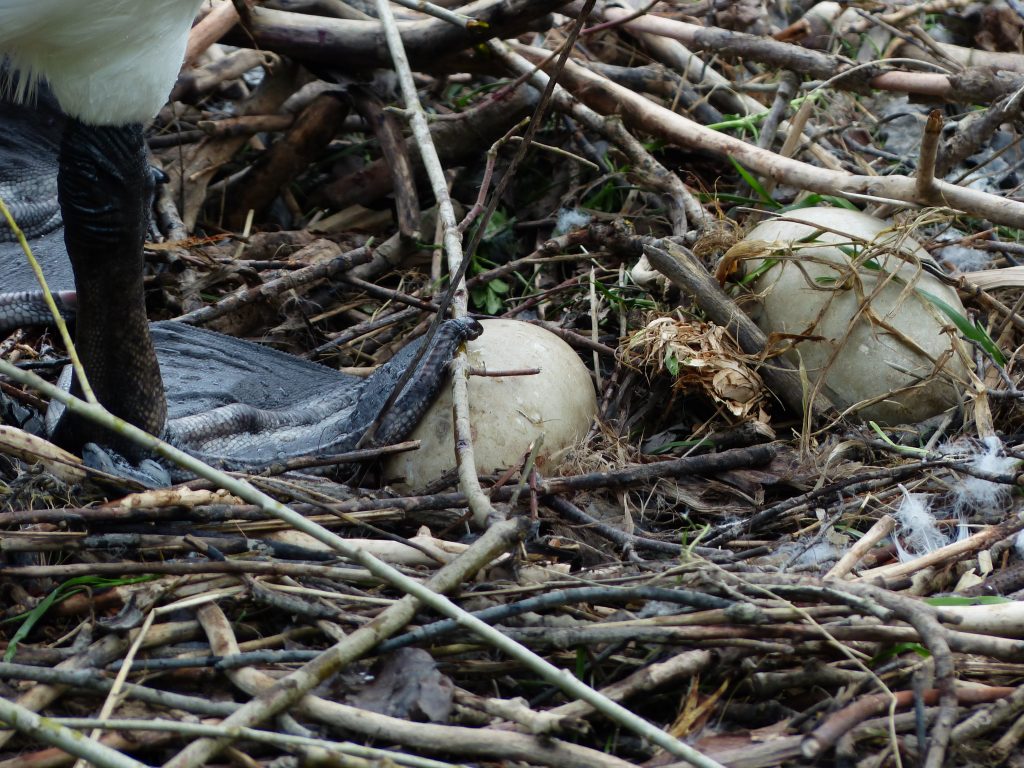Deterring Waterfowl
Geese, ducks and swans can be a beautiful part of our lake and stream ecosystems, but overly large populations can cause significant impacts on water quality, human health, and other native plants and wildlife. So what can you do to help keep overly large populations away from our lakes and streams? Following some of the suggestions below will help you make a difference.
Do Not Feed Waterfowl - Ever!

Feeding waterfowl is an understandably fun activity, especially for young children, but it is one of the biggest reasons that these populations have spiraled out of control in recent history. The single most important thing you can do to help protect water quality and human health is to pledge to STOP feeding all geese, ducks, swans, and even seagulls. Not only does feeding encourage these birds to stay in one place for long periods of time, but it also makes them more accustomed to human interaction, which in turn can make them act more aggressively towards people. In addition, bread and other human foods are not healthy for waterfowl – their native diet includes plants, seeds and insects, and human food lacks the nutrients and roughage needed to keep these creatures healthy.
Create a Barrier
Do you live on a lake or near a pond? Canada geese in particular prefer beaches or short mowed shorelines and are found in much larger numbers when these conditions—or, habitat—are available. The birds like open areas so they can watch out for predators, and planting a buffer of native grasses, flowers, or shrubs along your shoreline or utilizing native plants in your yard can create a visual block so that geese and swans will avoid those areas. A more natural shoreline not only keeps geese off your lawn, but it also helps protect water quality and provides great habitat for native insects and wildlife. Vegetative or rock barriers are often most effective, but even a simple fence can sometimes help discourage birds. Read on for basic ideas, but for more detailed information on how to create a natural shoreline, check out the Clear Choices Clean Water Shorelines page.
- Vegetative barriers: Simply leaving an unmowed strip of vegetation approximately 20-30 feet out from the shoreline is the easiest step you can take and a very effective method for deterring geese. Even better would be planting native shrubs, hedges, or other taller plants around the water. See the Shorelines page for more ideas on beautiful native shoreline plantings that do double duty as goose repellents. Interestingly, some research suggests that geese prefer fertilized grass to unfertilized, so taking the Clear Choices Clean Water Fertilizer pledge can also help deter waterfowl!
- Rock barriers: Large boulders, greater than 2 feet in diameter, placed along the shoreline may help impede waterfowl movement towards shore. This is even more effective when used in conjunction with vegetative barriers.
- Fence barriers: Even a simple fence can deter waterfowl from walking up onto your property. Any fence should be at least 30 inches tall and have openings no larger than 3 inches in diameter. Examples of effective fencing include woven wire, chicken wire, plastic snow fencing, or construction fencing. Again, effectiveness of this option is enhanced when it is used in conjunction with other methods.
Remove Nesting Materials or Destroy Eggs

If you have a large population of Canada Geese, you may need to take more aggressive measures to reduce or eliminate the group. Nest and egg destruction is one such action. Another approach is to trap the geese and either relocate or euthanize them. Both of these actions require permits. Several resources are listed below to help you if you are interested in these activities.
Hunting Geese and Ducks
Canada geese and ducks can be hunted in compliance with state and federal regulations during the regular waterfowl season from November to February, with specific dates varying annually. There is also a special early hunting season for geese that typically runs the first two weeks of September. Mute Swans are a federally protected bird and currently do not have a regulated hunting season, so refrain from hunting them! If a swan becomes a nuisance on your property, you can contact IDNR Division of Fish and Wildlife for assistance with control.
Other Deterrent Methods
Scare them away: Various methods are available for scaring geese away from your shoreline. Generally, loud noise making devices such as propane cannons, whistles, alarms, or pre-recorded goose distress sounds can be helpful when used in conjunction with other control methods. Be aware that noise making methods may require special permitting depending on local ordinances. Visual deterrents such as Mylar tape or scarecrows can also be effective, as well as regular patrol of the area by your dog!
Chemical repellents: There are a few chemical repellents available to control geese, but they tend to be used as a last resort due to their high cost and short duration of control. These are most often used in areas with significant human traffic, such as grassy picnic areas or parks. As with any chemical product, always use caution and follow label directions carefully when applying.